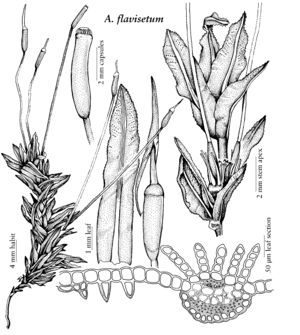Difference between revisions of "Atrichum flavisetum"
J. Proc. Linn. Soc., Bot., suppl. 2: 150. 1859,.
FNA>Volume Importer |
imported>Volume Importer |
||
| (One intermediate revision by the same user not shown) | |||
| Line 57: | Line 57: | ||
|publication year= | |publication year= | ||
|special status= | |special status= | ||
| − | |source xml=https:// | + | |source xml=https://bitbucket.org/aafc-mbb/fna-data-curation/src/2e0870ddd59836b60bcf96646a41e87ea5a5943a/coarse_grained_fna_xml/V27/V27_192.xml |
|genus=Atrichum | |genus=Atrichum | ||
|species=Atrichum flavisetum | |species=Atrichum flavisetum | ||
Latest revision as of 21:24, 5 November 2020
Plants medium-sized, green or light green when wet, dark green when dry. Stems to 2 cm, often branched by subfloral innovations. Leaves ca. 10, oblong-linear, acute to acuminate, transversely undulate distally, toothed along the margin nearly to the base, with irregular abaxial teeth corresponding to the undulations; costa percurrent to weakly excurrent; lamellae 4–6, 2–4 cells high; median leaf cells 24–30 µm wide, moderately thick-walled, ± isodiametric, transversely elongate. Sexual condition synoicous; perichaetia terminal or on an innovation continuing growth of the shoot and forming new perichaetia, several successive inflorescences with maturing capsules persistent on one stem; perigonia inconspicuous, hidden amid the perichaetial leaves. Seta (1–)2–4 per inflorescence, to 3.5 cm, rather slender, straw-yellow. Capsule 8 × 1.3 mm, erect to inclined, short-cylindric, nearly straight. Spores (8–)15–16 µm.
Phenology: Capsule maturity date not determined.
Habitat: Banks or stumps in woods, roots of fallen trees, ravines in crevices of rock outcrops
Elevation: low to moderate elevations
Distribution

B.C., Wash., e Europe, Asia.
Discussion
Atrichum flavisetum appears to be rare in North America and its distribution is poorly known. In the Old World it is known from European Russia, the Ural Mountains, the Caucasus, the Russian Far East, central Asia (Altai), China and the Himalayas. It is almost inseparable from A. undulatum by leaf characters alone, but usually fruits freely. The species is synoicous, but the antheridia and archegonia are not intermingled. The antheridia are central in position, associated with minute perigonial bracts; the archegonia arise at the periphery of the common involucre (C. Warnstorf 1914). Besides the inflorescence, A. flavisetum differs by its ecology, and the slender, yellowish seta and smallish capsules, which are short-cylindric and nearly straight. Older sporophytes often persist from successive inflorescences, seemingly lateral in position.
Selected References
None.
